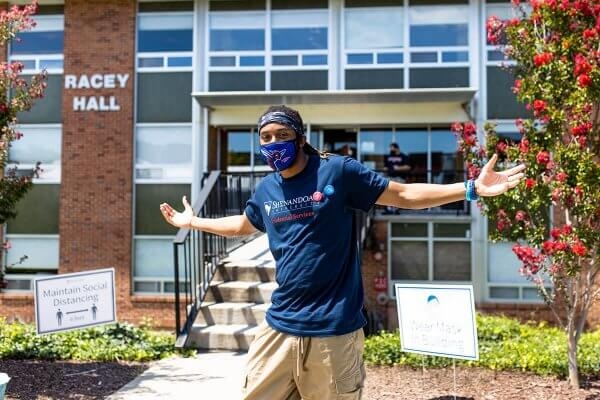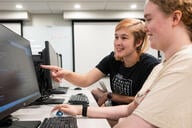You have /5 articles left.
Sign up for a free account or log in.

Shenandoah University
For private colleges, this year has been among the most difficult ever in admissions. For those that aren't nationally known (we're leaving out the Ivies, Stanford University and similar institutions), admissions is always a challenge. In most states, public universities dominate press attention. For many, they define higher education, with their large size, big-time athletics and more. This year has been no exception. Think about how many stories you saw (including on this site) about the University of North Carolina's reversal of its decision to open its Chapel Hill campus. While the big-time sports conferences do have private university members, most are public.
What about smaller private colleges?
A scan of private colleges suggests that they are welcoming some or all students to campuses, and they are hopeful that they will be able to avoid the embarrassing incidents (parties without social distancing or face masks) that have taken place at so many larger, public institutions. They have worked hard all summer long to meet their enrollment goals -- or to get as close to full as possible. They have rules covering everything from how long parents can remain on campus to how frequently students will be tested.
The early indications reflect that colleges are dealing with different situations than normal this year. Some colleges have yield totals; others don't. Some colleges are counting students who are studying remotely and others don't.
Angel B. Pérez, CEO of the National Association for College Admission Counseling, said, "My members have shared that melt is growing higher than expected in August, as schools get closer to opening. Fear of COVID, anxiety about online education, international students with an inability to travel, and increased anxiety about costs has pushed more students to change course."
Still, a number of private colleges are reporting successes.
Take Shenandoah University, in Virginia. As of Wednesday, the university had 532 committed freshmen (yield rate: 27 percent). Last year on this same date the college had 515 (yield rate: 30 percent). While the university expects to lose a few students at the beginning of the academic year, as it always does, it anticipates having its largest-ever freshman class.
Andy Woodall, assistant vice president for recruitment and admissions, said via email, "By the time we were forced to begin working remotely, we were already well on our way to executing our trial period of virtual visits, which meant we could use the knowledge gained for our virtual open houses and virtual admitted freshmen day. I doubt we used a tool set that was all that different from other admissions offices, but I think we may have been more familiar with those tools earlier than most."
He said the admissions staff really stepped up. "The university has done an exceptional job of planning, executing and communicating throughout this crisis," he said. "With move-in day being yesterday and today and throughout the summer at our in-person orientations, we've consistently heard from parents that they have been impressed with our communication, transparency and planning. That level of comfort has meant a ton to those families in solidifying their choice to choose SU."
Or consider Colorado College. Mark Hatch, vice president for enrollment, said that the college enrolled one more freshman than its target of 570 -- and that was despite having set a pre-coronavirus goal of increasing the size of the class by 25.
Colorado in fact had 635 deposits on May 2, but it has lost students (and gained a few) in the weeks since. In mid-April, the college admitted 11 students off the waiting list, but "we didn't go hog wild" with it, Hatch said.
Of the 64 students the college lost, half were international and could not make it to campus.
Colorado is best known for the "block plan," in which students take only one course at a time (for shorter time frame than a semester). Hatch isn't sure of the impact of the block plan, but he said that coverage of the block plan -- other colleges adopted it this year, thinking it would be better to schedule that way -- "is great."
Even with a record class enrolling, Colorado has not been without problems. More than 100 students are quarantined because one of their dorm mates tested positive for the virus.
Larger-than-typical "summer melt" is also a norm for this year, although in some cases colleges admitted enough students that they are happy with the results.
At Assumption University, in Massachusetts, the college had 609 deposits in June. Michael K. Guilfoyle, a spokesman, said that was up from 593 at the same time last year.
As of last week, the university had 585 students still planning to attend. Key to keeping students coming was the creation of a $3 million fund for grants to new and continuing students with extra financial needs because of the coronavirus. Of new students, 176 are receiving grants from the fund.
At Hamilton College, from an applicant pool of 7,443, admission was offered to 1,370 first-year candidates (including 17 from the waiting list), and 470 students from that admitted cohort chose to enroll. The yield was 34.3 percent, compared with 34.7 percent a year ago. "Of our 470 students, 438 are starting on campus this fall, and 32 had to defer to join us in the spring due to travel or health issues related to the pandemic," said Monica C. Inzer, vice president for enrollment management.
Via email, Inzer said she's proud of the students. "They did not give up on their futures, and many of them had to quarantine for 14 days to be eligible to arrive on our campus, where they are dutifully wearing masks, being tested and retested for COVID, and accepting their new normal. Never before has the arrival of a class been more anticipated, and never before has a class (and their parents!) been more grateful to be on campus. At least in my 30-plus years of doing this. Here’s hoping we can keep them until Thanksgiving," she said.
Bucknell welcomed its largest-ever incoming class -- 991 students -- last Monday. The target was 990, and Bucknell had a scare on yield last year. The college had 1,032 students signed up in June.
Over all, Bucknell enrolled 3,724 students, including 30 graduate students, and 338 chose to study remotely.
Lewis & Clark College has a goal of 526 freshmen this year. As of June 1, it had 565. That went up to 570, and hovered there for a few weeks. In August, it fell a bit, but the college is still ending up with 521 students.
Of those students, however, about 55 are studying remotely -- paying full tuition, but no room and board.
Also in Portland, Ore., Reed College has 400 students, in excess of its goal of 385 to 395.
Missing Goals
Muhlenberg College had a goal in June of 550 students in the freshman class. It will have 525 students either in person or online, and 38 students have deferred either a semester or a year.
At Salve Regina University, in Rhode Island, James R. Fowler Jr., vice president for enrollment management, said that the institution originally hit its goal for new students for the year, 570, but "higher melt" means that the university will end up 4 to 5 percent off that goal. "The majority of that melt have been deferrals, not straight-out withdrawals," he said. The university got a number of late acceptances from local students who wanted to be close to home. That also led to a 15 percent increase in transfer students.
He said, "I believe that the keys to our stability throughout this time of national crisis have been our size and location."
He explained that "Rhode Island has been ahead of the curve in virus mitigation, social distancing and mask wearing due to strong leadership from the governor's office, and Newport has done an excellent job of enforcement and messaging on mask wearing and safe operations prioritizing public health … As a small school with a student population that has chosen Salve for our mission centered on working for a better world, we feel we are uniquely positioned to manage this challenge."
Fowler also said Salve Regina has "de-densified campus housing by partnering with the Newport Marriott, and our class sizes are already small." (Average size of 19, with no classes over 30.) This allows "for safe, socially distanced classrooms."
At Otterbein University, in Ohio, the goal for the year was 623 -- in June. Summer melt was low (4 percent), but the university only hit 533 deposits. That totaled 510 new freshmen who start class today.
Jefferson R. Blackburn-Smith, vice president for enrollment and marketing, said the university is using a phased move-in, and 60 percent of classes will begin the term online. He said that Otterbein has also been good about sharing the best available information with students and parents.
Furman University, which had a goal of 635 pre-COVID-19, will miss that goal by about 12 percent. Furman "buffered this a bit with a slight uptick in retention and transfers," said M. Brad Pochard, associate vice president for enrollment and dean of admission and financial aid.
At Albertus Magnus College, in Connecticut, students are expected to enroll tomorrow. All students will receive a PPE kit and hand sanitizer. Yield has fallen, from 23 percent to 14 percent.
Knox College, in Illinois, had an original goal of 320 freshmen. Classes start Sept. 14, and the college is currently expecting 316 students. That loss is largely due to international students who can't get to the United States.
"We’re only expecting 23 international students, down from 74 last year," said Paul Steenis, vice president of enrollment and dean of admission.
"We’re offering a combination of in-person, hybrid and virtual classes and expect most students to return for an in-person experience for the fall," he said. "Some number, especially our international students, may be unable to return or prefer to study remotely." He said he was convinced Knox faculty would teach well in any format, but that "some experiences, especially those beyond the classroom -- athletics, student leadership opportunities, and theater, dance, and musical performances, among others -- may be quite different during this pandemic. They might not be everything that students had hoped for."
Knox is still hopeful. It is offering a fifth year, tuition-free, to most students.
Inzer of Hamilton said, "This will be a year for the ages (I hope!), and I’d like to not have to repeat it ever again. But something tells me the next one is going to be another fasten-your-seatbelt roller coaster ride."




